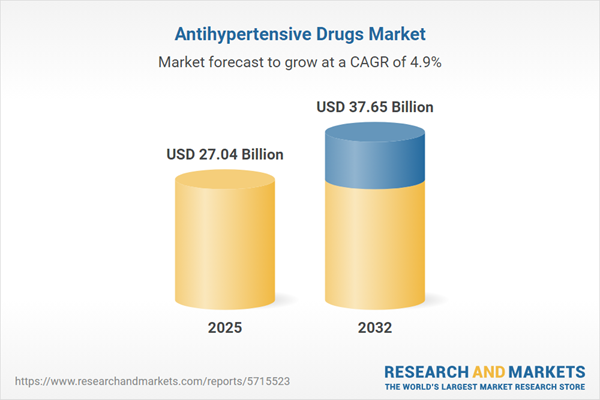Speak directly to the analyst to clarify any post sales queries you may have.
The antihypertensive drugs market is evolving rapidly, shaped by ongoing innovation, digital integration, and a shifting regulatory landscape. For senior leaders, navigating this environment with reliable market intelligence is essential for strategic decision-making and organizational growth.
Market Snapshot: Antihypertensive Drugs Market Growth Outlook
The antihypertensive drugs market is on a consistent path of expansion, with growth forecast from USD 25.76 billion in 2024 to USD 27.04 billion in 2025 and a projected reach of USD 37.65 billion by 2032, demonstrating a CAGR of 4.85%.
Market momentum is being driven by advancements such as precision medicine, the integration of digital health technologies, and the introduction of novel therapies. Alongside these, regulatory adjustments, reinforced supply chain strategies, and new models for patient management are creating opportunities for both existing firms and emerging players to shape strategic direction in a competitive field.Scope & Segmentation
This report offers a comprehensive examination of the antihypertensive drugs sector, providing detailed insights into market segmentation, regional trends, and operational strategies. These findings empower decision-makers to address evolving industry challenges and seize new growth opportunities.
- Therapeutic Classes: Includes ACE inhibitors, angiotensin receptor blockers, beta blockers, calcium channel blockers, and multiple categories of diuretics, together informing approaches to targeted research and product lifecycle planning.
- Therapy Types: Assesses the landscape for monotherapy and combination regimens, clarifying priorities for clinical development and helping guide investment in evolving patient care pathways.
- Administration Routes: Compares oral and injectable delivery forms, offering guidance on patient preference and deployment in diverse settings from acute care to chronic disease management.
- Dosage Forms: Covers tablets, capsules, oral solutions, and injectables, informing adaptability in both outpatient and inpatient scenarios where flexible treatment options are required.
- Distribution Channels: Maps the influence of hospital pharmacies, retail channels, and online pharmacies, clarifying patterns in buyer behavior and evolving market access approaches.
- End Users: Evaluates the market roles of clinics, hospitals, and home care, providing context for effective resource allocation and enabling broader access to treatment as healthcare delivery decentralizes.
- Regions Covered: Offers insights for the Americas, Europe, Middle East & Africa, and Asia-Pacific, supporting strategy development that aligns with varying regional regulations and local needs.
- Key Companies Analyzed: Details initiatives and strategies of Novartis AG, Pfizer Inc., AstraZeneca PLC, Sanofi S.A., Merck & Co., Boehringer Ingelheim International GmbH, Bayer AG, GlaxoSmithKline plc, Teva Pharmaceutical Industries Ltd., and Viatris Inc. for market expansion and innovation.
Key Takeaways for Senior Decision-Makers
- Pharmacogenomics is enhancing the identification of patient subgroups, leading to more tailored therapy options and improved care efficiency.
- Adoption of digital health is supporting remote patient monitoring and improving medication adherence, contributing to higher engagement and reliable outcomes.
- Efforts in regional sourcing and supply chain transparency are increasing operational resilience for organizations addressing regulatory and logistical shifts.
- While monotherapy is often used for initial treatment, combination therapies provide scalable solutions for managing complex hypertension cases across various care environments.
- Successful market strategies depend on navigating evolving regulations and adapting investment approaches, with attention to the balance between patented medications and generics to ensure localized fit.
- Collaborations between pharmaceutical companies and digital technology providers are accelerating the transition to integrated, patient-focused care and enhancing technology-driven service models.
Tariff Impact on the Antihypertensive Drugs Market
Recent changes in U.S. tariffs are prompting manufacturers in the antihypertensive drugs market to enhance international supply chain strategies. In response, companies are relocating production facilities, building stronger regional partnerships, and investing in advanced manufacturing techniques. These actions—including adopting nearshoring and expanding contract manufacturing—strengthen supply reliability, support regulatory compliance, and improve agility in meeting domestic demand.
Methodology & Data Sources
The analysis in this report is based on direct engagement with senior industry executives and cardiology experts. Data is validated through clinical trial evaluations, regulatory document reviews, leading industry publications, and public financial records, with SWOT and Porter’s Five Forces frameworks ensuring robust market and competitive analysis.
Why This Report Matters
- Delivers a detailed breakdown of market segmentation and regional variations, enabling targeted capital deployment and effective resource alignment.
- Supports development of effective operational and strategic plans by clarifying supply chain risks, channel evolution, and the influence of reimbursement policies.
- Helps leadership integrate technological advances and clinical trends in hypertension management into actionable commercial strategies.
Conclusion
With these insights, senior decision-makers gain the perspective necessary for agile planning and informed strategy in the evolving antihypertensive drugs market. This enables organizations to remain competitive and responsive to emerging industry demands.
Additional Product Information:
- Purchase of this report includes 1 year online access with quarterly updates.
- This report can be updated on request. Please contact our Customer Experience team using the Ask a Question widget on our website.
Table of Contents
3. Executive Summary
4. Market Overview
7. Cumulative Impact of Artificial Intelligence 2025
List of Figures
Samples

LOADING...
Companies Mentioned
The key companies profiled in this Antihypertensive Drugs market report include:- Novartis AG
- Pfizer Inc.
- AstraZeneca PLC
- Sanofi S.A.
- Merck & Co., Inc.
- Boehringer Ingelheim International GmbH
- Bayer AG
- GlaxoSmithKline plc
- Teva Pharmaceutical Industries Ltd.
- Viatris Inc.
Table Information
| Report Attribute | Details |
|---|---|
| No. of Pages | 195 |
| Published | October 2025 |
| Forecast Period | 2025 - 2032 |
| Estimated Market Value ( USD | $ 27.04 Billion |
| Forecasted Market Value ( USD | $ 37.65 Billion |
| Compound Annual Growth Rate | 4.8% |
| Regions Covered | Global |
| No. of Companies Mentioned | 11 |









